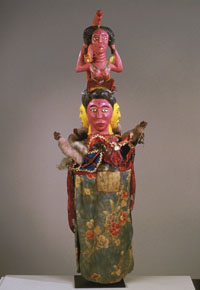
Some of the complexities of objects in transition and travel are explored through the festive wooden masks associated with the Ode-lay society of late 20th-century Freetown, Sierra Leone. |
Noted scholar Patrick McNaughton once wrote that "the opportunistic transformation of other people's traditions is an essence of creativity and art history in Africa, as in many other areas of the world."
That theme will be explored in the exhibition "Call and Response: Journeys of African Art" opening Friday, Dec. 15, at the Yale University Art Gallery.
The show -- which features African masks, sculpture and mixed media works from two private collections whose owners wish to remain anonymous -- traces the way ideas and objects that originated in one ethnic group are adopted and reconfigured by other groups, both within and outside of the African continent. The artworks are augmented by turn-of-the-century postcards, books, maps and textiles that help guide the viewer on a journey of changing forms, definitions and circumstances.
The exhibition was conceived and organized by Yale doctoral candidates Sarah Adams, Barbaro Martinez-Ruiz and Lyneise Williams, under the direction of Joanna Weber, assistant curator of European and contemporary art. It is accompanied by a fully illustrated catalogue with essays by the exhibition organizers and their adviser, Robert Farris Thompson, the Colonel John Trumbull Professor of the History of Art. The catalogue is on sale in the museum store.
Visitors to the show are greeted by a video of a dancer wearing one of the masks from the exhibition. The objects on display are grouped more or less thematically.
The first installation, organized by Adams, focuses on Igbo women's body painting, ùrì. A sculptured puppet in the exhibition shows how a young woman's body was covered with elaborate patterns to make her more comely before her marriage. In the face of European missionary disapproval these young women began to wear clothes and the custom of body-painting declined, explains Adams; the designs, however, were adapted to other uses. One Scottish missionary, Agnes Arnot, collected them as drawings on paper which were then used as templates for embroidery. Examples of these embroidered linens from the 1930s and 1940s, which "had a ready sale among Europeans all over Nigeria," are in the exhibition.
Some of the complexities of objects in transition and travel are explored by Williams through the festive masks associated with the Ode-lay society of late 20th-century Freetown, Sierra Leone -- several examples of which are in the exhibition. She also considers the emblem of the Leopard Society (Ngbe) as adopted by the Efik during the late 18th and early 19th centuries. Along with the large Ngbe Society emblem made of animal skulls, turtle shells, horn, fiber, wood and rattan, she has installed a trunk containing materials related to the ongoing life of the society, some of them originating as close as Bridgeport, Connecticut.
Ruiz-Martinez's concern in this exhibition is nkisi, a type of religious object that exists in a three-dimensional and a graphic form -- both of which are on view. In the Kongo culture the figures -- in the shape of men or animals -- have powerful healing and protective powers. These figures and the related beliefs were adopted in Africa, as well as in Ruiz-Martinez's native Cuba.
In addition to the items from the private collections, the exhibition will feature artworks from the National Museum of African Art, the Smithsonian Museum and the Yale University Map Collection of the Sterling Memorial Library.
T H I S
Bulletin Home
 W E E K ' S
W E E K ' S S T O R I E S
S T O R I E S![]()
 Yale experts to explore 'Democratic Vistas' in DeVane Lecture series
Yale experts to explore 'Democratic Vistas' in DeVane Lecture series![]()
![]()
 Three Elis win Rhodes Scholarships
Three Elis win Rhodes Scholarships![]()
![]()
 State honors Yale's efforts in 'revitalizing' urban areas
State honors Yale's efforts in 'revitalizing' urban areas![]()
![]()
 ENDOWED PROFESSORSHIPS
ENDOWED PROFESSORSHIPS![]()
 Comedian alternates wit, seriousness in election analysis
Comedian alternates wit, seriousness in election analysis![]()
![]()
 'Circa 1701' features portraits of contemporaries of Elihu Yale
'Circa 1701' features portraits of contemporaries of Elihu Yale![]()
![]()
 Religion and communication are among the important issues as terminally ill . . .
Religion and communication are among the important issues as terminally ill . . .![]()
![]()
 Stern recalls New Haven's role as 'original Model City'
Stern recalls New Haven's role as 'original Model City'![]()
![]()
 Study: Caffeine doesn't create dependence on over-the-counter pain relievers
Study: Caffeine doesn't create dependence on over-the-counter pain relievers![]()
![]()
 Exhibition will explore 'the opportunistic transformation' at the heart of African art
Exhibition will explore 'the opportunistic transformation' at the heart of African art![]()
![]()
 Tumbling Time: A Photo Essay
Tumbling Time: A Photo Essay![]()
![]()
 Service to honor memory of Yale employee Lucy Cunningham
Service to honor memory of Yale employee Lucy Cunningham![]()
![]()
 In the News
In the News![]()
![]()
 Yale Scoreboard
Yale Scoreboard![]()
 |
| Visiting on Campus
Visiting on Campus |
| Calendar of Events
Calendar of Events |
| Bulletin Board
Bulletin Board![]()
Classified Ads |
| Search Archives
Search Archives |
| Production Schedule
Production Schedule |
| Bulletin Staff
Bulletin Staff![]()
Public Affairs Home |
| News Releases
News Releases |
| E-Mail Us
E-Mail Us |
| Yale Home Page
Yale Home Page